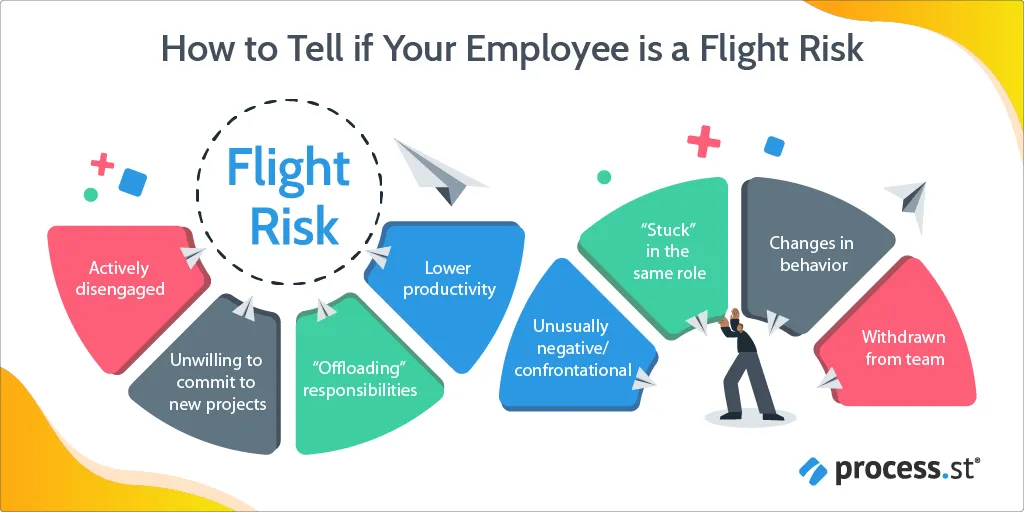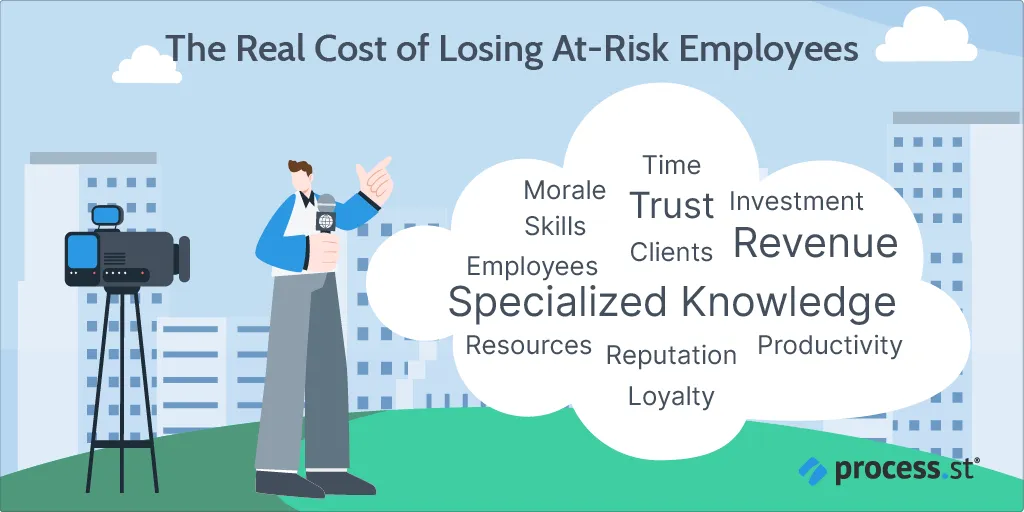How to Keep Your Flight-Risk Employees From Taking Off
Blog: The Process Street Blog

25% of employees are at risk of leaving their job this month due to unhappiness at work.
Not taking into consideration the financial, labor, and time resources required to replace a single employee, what would it cost to lose 1/4th of your workforce right now?
How quickly could you replace them?
More importantly: How quickly could you replace their unique knowledge and skills?
Probably not before the next 25% walked out the door.
Sure, this is all a bit hyperbolic. That 25% is spread across companies and industries but it drives the point home.
Replacing even one employee isn’t cheap, quick, or easy. To rephrase my previous question: How many employees can you afford to lose per month?
No worries. Process Street has you covered. This post will go over everything you need to know (plus a few free templates) to keep those flight-risk employees grounded:
- What creates flight-risk employees?
- How to identify an at-risk employee
- 5 ways to keep flight-risk employees on board
- Parting is such sweet sorrow
What creates flight-risk employees?
Dissatisfaction, pure and simple.
This comes out in a variety of ways, but dissatisfaction is the foundation it all builds from. You may think you know who your flight-risks are – junior employees or new hires that haven’t been with the company long enough or don’t know what they want to do yet – and you’d be wrong.
Your top flight-risks are your top performers. In fact, you’ve probably heard them referred to as “rising stars.” You may even have a few yourself. If you’re not careful, those stars will rise right out of your company.
Seeking a higher salary or promotion
Pay has, is, and likely always will be a contentious issue, even before hiring an employee. Job seekers want to know the salary before they apply; in other words, are you worth their time?
Once hired, continued pay transparency plays a lot of importance when it comes to employee satisfaction.
How is salary calculated? How does an employee’s pay compare to the current market? Does their salary increase with cost-of-living increases?
If you look at the research from Payscale below, it’s obvious that employees have very little idea of how their salaries compare to others in the industry – and more often than not, feel they’re being paid below market.

Seeking new challenges
As I said, your highest flight-risks are your highest performers. These are not people who’ll be content to sit around the office twiddling their thumbs. They won’t be satisfied with the same day-to-day routine all the time.
Top talent craves challenge. They need a problem to solve or a puzzle to figure out. There’s a reason they perform so well, after all. You wouldn’t attach a racehorse to a plow so don’t hobble your prized champions or they’ll jump the fence before you can stop them.
Seeking new opportunities
You might think “new opportunities” is just another way to say “new challenges” or “promotion.” Sure, those both offer new opportunities, but it’s also a very narrow view of what an opportunity can be.
An employee who feels they’re stagnating or not developing at work is more likely to get bored and more likely to “step out,” so to speak. Humans tend to follow patterns of behavior, and if they feel like they’re missing out on something, they’re going to find a way to get it.
Seeking a better work/life balance
The media has painted the classic overachiever as ruled by ambition, the thrill of a 120-hour workweek, and never having to unplug. After all, 120 hours still leaves a solid 7 each night for sleeping.
Those 7 hours get sucked up pretty quick when you factor in commuting, eating, basic hygiene, socializing, grocery shopping, walking the dog, reading a book article blog tweet – oh, and when was the last time you cleaned your kitchen? Doesn’t matter; you don’t use it anyway.
Real humans, on the other hand, aren’t so great at functioning like that. Go ask any med student.
Experiencing major life changes
Births. Deaths. Marriages. Pandemics. Dystopian politics.
These all make people re-evaluate their circumstances and what they want to achieve. One of those re-evaluations might be whether or not their job is as important – or fulfilling – as it used to be.
This is the cause you can do the least to prevent or resolve. While some of these major events can be planned for in advance (marriages, births, etc.), others will be completely unpredictable.
There are a few things you can do to mitigate the loss of a valued employee, which I’ll go over later in the post.
How to identify an at-risk employee

Generally speaking, the overlap of indicators between your disengaged employees and your at-risk employees is a circle.
While disengaged employees are usually at-risk as well, the catalyst for flight-risk employees isn’t necessarily a lack of engagement.
So how do you spot an employee who’s about to take off?
Change in work habits
This doesn’t mean suddenly having more “doctor appointments” or wearing more interview-appropriate attire to work. Those pretty obvious signs aren’t very likely.
These changes will likely be more subtle and easier to overlook. You probably won’t notice them at all unless you’re looking for them.
Some indicators might be:
- Taking breaks more often;
- Less attention to detail;
- Decreased time management;
- Lack of prioritization.
Unusually negative attitude
At-risk employees aren’t usually flight-risks because they’re happy with their environment. Unhappy people tend to be more negative than usual – particularly towards whatever or whoever is making them unhappy.
Everyone has a bad day now and then, so just because Susan was a little grumpy on Wednesday doesn’t mean she’s a flight-risk. However, if Susan’s been unusually grumpy for a few weeks now, you might have a bigger problem on your hands than a little inter-office conflict.
Click here to add our Office Conflict Resolution workflow to your free Process Street account.
Lower productivity
Think about the last task you found unfulfilling. Did you throw yourself into it wholeheartedly or did you try to get it done as quickly as possible?
Personally, I tend to drag my feet and only get around to it at the last minute when I absolutely have to.
Either way, you end up with lower quality results and lower overall productivity. Rushing through a task (either because you want to get it over or because you haven’t left enough time) means it’s inevitably going to contain errors that wouldn’t be there with more attention to detail.
Since it wasn’t done correctly, either you (or someone else) is going to have to make corrections, which slows the whole process down. The slower it takes for one deliverable to be finished, the longer it takes for the next to be started.
More withdrawn from team activities
This might be simply participating less during meetings or it could be not socializing as much outside of work.
An employee who suddenly starts having lunch outside the office might be looking for a way out – or just trying to get away from an environment they’re unhappy in.
Keep in mind that withdrawing from the team doesn’t necessarily mean they’re sneaking out to attend interviews. Your quieter employee could be feeling isolated or lonely because they don’t have someone to discuss their dissatisfaction with.
There are a number of reasons someone might become more withdrawn at work, but it’s usually a safe bet you should check in with them.
Unwillingness to commit
Susan usually jumps at every chance to head a project – and she usually does. She does high-quality work, delivers ahead of schedule, and makes a great leader.
A new project comes up. Super important, super complex. It’s going to take at least 6 months to lay the groundwork and maybe even longer to fully complete. You take for granted that Susan will lead the team – but she says no.
You try to make it more attractive to her – it is a really good opportunity, after all – but she stays firm. She tells you to find someone else.
Susan’s unwillingness to commit to your project is a decent indicator that she’s about to commit to someone else’s.
Lack of motivation
For students it’s called “senioritis” but it’s not exclusive to students.
Senioritis is a lack of motivation towards work because you’re nearing the end of the school year (or job tenure). You see this displayed in a number of situations – a person mentally and emotionally leaves an environment before they physically do.
If someone is about to move or retire, you might hear friends or coworkers say that the person has already “checked out” or isn’t “mentally there.” People also tend to “check out” of a relationship before a breakup or divorce.
I wouldn’t be surprised if your at-risk employee “checked out,” too.
5 ways to keep flight risk employees onboard

Address pay inequalities with pay transparency
Pay transparency isn’t about publicizing what every person in the company earns; that will make no one happy, especially not your employees. Pay transparency is about communicating the process, though.
The fascinating thing Payscale found out?
People don’t care about the amount so much as the fairness.
Use incentive schemes for meeting goals & objectives
I know – we’re always going on about rewards and recognition. Thing is, we wouldn’t be doing that if it didn’t work.
No one wants to work hard day after day without even the slightest bit of appreciation. Would you?
There are a lot of ways you can offer your employees incentives, from establishing a kudos system to gift cards to even just taking a minute to say, “Hey, I really appreciate the work you did on that presentation.”
Framing it as a team competition can also add a little more excitement to the day (remember when I mentioned new opportunities?).
Incentivizing goals and objectives is a simple and effective way to show your employees that their contributions are noticed, valued, and important to you. As they say, a little appreciation goes a long way.
Re-evaluate progression routes
Do your employees have a clear career progression plan? Do they know what their advancement opportunities are, how to achieve them, and if they even want to pursue them?
What learning and development programs do you have set up? If an employee wants to become more skilled in a particular area, what’s the process for doing that? Does your company offer assistance with external training programs?
Keeping your employees informed about where their career is going and the projected timeline will reassure them that they do have a future with your company that’s worth sticking around for.
Click here to add our Career Progression Plan Template to your free Process Street account.
Conduct “stay” interviews
Everyone knows about the hiring interview and the exit interview. You may not be as familiar with the stay interview.
According to Dick Finnegan, author and CEO of C-Suite Analytics, the key to creating a great place to work is building trust between managers and employees. What he means by this is not the simple and somewhat superficial trust involved in job performance and security.
He’s talking about regular one-on-one meetings between manager and employee that are about more than just, “So how is suchandsuch project coming along?” These meetings – these stay interviews – are about getting to know your employees’ motivations and interests, what makes them tick and what’s going on in their lives.
I am not a good follower. I’m used to being the one in charge and my ideas being the best ideas. I do have pretty good ideas, but as part of a team, this can cause some friction.
Fortunately, my manager knows that my frequent and persistent questions about the purpose of doing things a particular way aren’t just me being a pain in the ass or challenging his authority.
How does he know this?
Because once a week since I started at Process Street, we’ve had one-on-one meetings to discuss everything from work things to life things to the woes of new puppy ownership.
As a result, he knows that, while I may be a pain in the ass, I’m a well-intentioned pain in the ass. Likewise, I know I have a psychologically safe environment and his support whether I have a work problem or a personal problem.
It’s not so easy to take an interest in every single employee’s life and career because we just like some of them more than others. We’re more attracted to some of them more than others because they are human and so are we. But […] we better be really good really good at taking interest in their lives and in their career.
– Dick Finnegan, CEO of C-Suite Analytics
The point of the stay interview is to catch any problems or issues before they become problems or issues. It’s a pretty basic – but incredibly effective – process where a manager sits down with their employees on a regular basis to see how things are going.
The employee can talk about areas where they might be struggling, things they wish were different, resources they need to perform better, etc.
By keeping these channels of communication open, the employee is able to voice their dissatisfaction early enough that it can be addressed before they decide to take flight.
For it to work, though, managers have to act on that feedback. If you don’t, trust breaks down completely and you’re even more likely to lose that employee to another company.
Click here to add our Employee Pulse Survey workflow to your free Process Street account.
Provide sufficient support
There will be unavoidable things that cause an employee to leave. It could be a range of things from family illness to moving to a new location to a change in priorities.
This doesn’t have to be the end of their relationship with the company, however. There are numerous solutions available if the employee needs to work less or take time off, such as sabbaticals, job-sharing, or flex hours.
The employee may still need to leave the company, but as long as you offer them appropriate support and understanding, it’s likely they’ll return if they can. At the very least, they’ll walk away still maintaining a good relationship with you and may potentially refer other colleagues to apply.
(Plus your other employees will see how you handle the situation, which will naturally boost trust and morale.)
Click here to add our Employee Parental Leave Request & Preparation workflow to your free Process Street account.
Parting is such sweet sorrow
You never want to see an employee leave. They’re hard (and expensive) to replace and you naturally want to hold onto your top talent as long as possible.
An essential part of accomplishing that is keeping up with how your employees are doing – and even more importantly, how they feel about their roles within your company.
The templates included in this post are just the tip of the iceberg in terms of what process automation can do for your employee engagement. It seems counterintuitive, right? “Automation” usually means taking the human out of the equation – ATMs, self-checkouts, chatbots – and, okay, process automation is also about taking the human out of the equation.
The difference here, though, is that automating your processes takes the human out of the tedious, repetitive task equation so they can spend more time with, well, other humans. And that’s what we’d all rather be doing, right?
Process Street workflows come with a variety of features such as rich HTML email generators (who hates writing emails?  ), custom form fields, and media like videos, GIFs, and pictures to really add that “wow” factor.
), custom form fields, and media like videos, GIFs, and pictures to really add that “wow” factor.
Okay, I may be getting a little excited, but there really is a lot that workflows can do for you. Add in Process Street Automations, Zapier integrations, SlackApp, and Pages – our free-forever central knowledge base) – and we’ve pretty much got it all covered.
Templates included in this post:
- Office Conflict Resolution Checklist
- Employee Pulse Survey Template
- Employee Parental Leave Request & Preparation Workflow
- Career Progression Plan Template
How do you keep your high fliers on the right course? Let us know in the comments!
The post Blog first appeared on Process Street | Checklist, Workflow and SOP Software.
